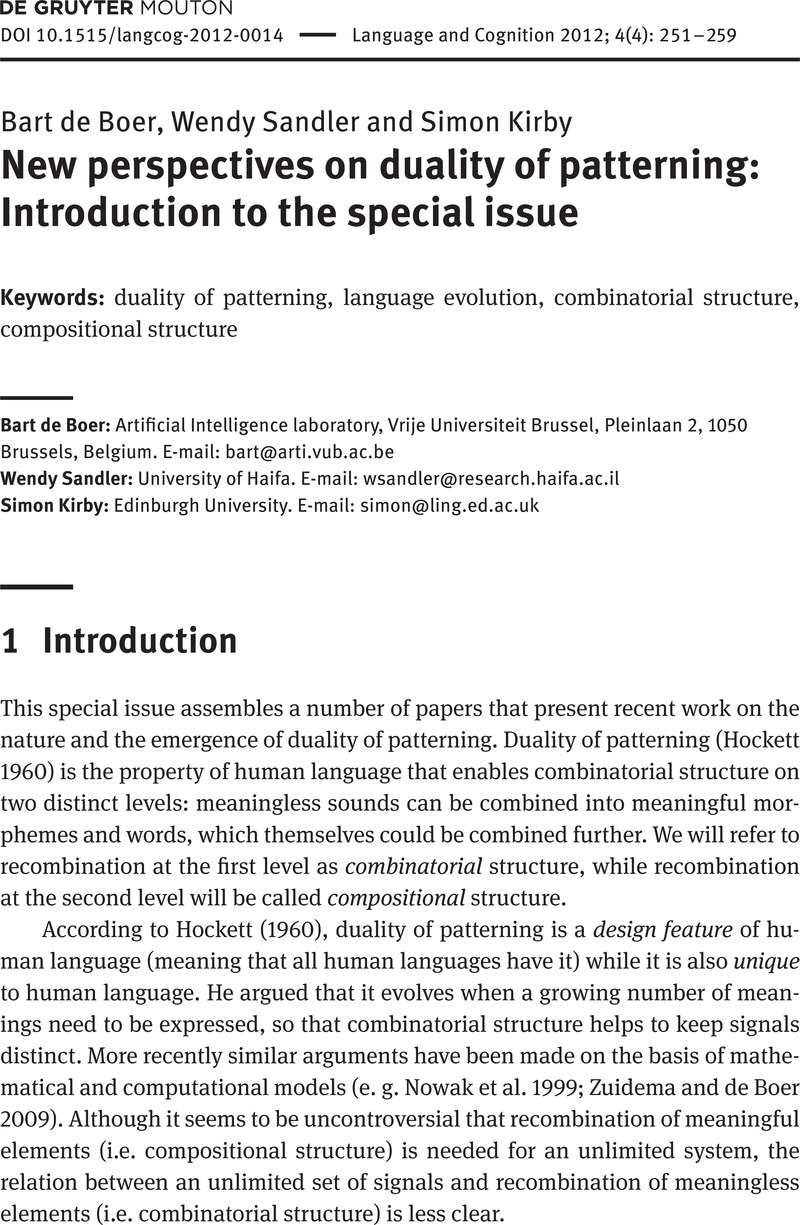Crossref Citations
This article has been cited by the following publications. This list is generated based on data provided by Crossref.
Giudice, Alex Del
2012.
The emergence of duality of patterning through iterated learning: Precursors to phonology in a visual lexicon.
Language and Cognition,
Vol. 4,
Issue. 4,
p.
381.
Sandler, Wendy
2013.
Vive la différence: Sign language and spoken language in language evolution.
Language and Cognition,
Vol. 5,
Issue. 2-3,
p.
189.
Elliott, Eeva A.
and
Jacobs, Arthur M.
2014.
Phonological and morphological faces.
Sign Language & Linguistics,
Vol. 17,
Issue. 2,
p.
123.
Collier, Katie
Bickel, Balthasar
van Schaik, Carel P.
Manser, Marta B.
and
Townsend, Simon W.
2014.
Language evolution: syntax before phonology?.
Proceedings of the Royal Society B: Biological Sciences,
Vol. 281,
Issue. 1788,
p.
20140263.
Sandler, Wendy
Aronoff, Mark
Padden, Carol
and
Meir, Irit
2014.
The Cambridge Handbook of Linguistic Anthropology.
p.
250.
Kockelman, Paul
Enfield, N. J.
and
Sidnell, Jack
2014.
The Cambridge Handbook of Linguistic Anthropology.
p.
183.
Engesser, Sabrina
Crane, Jodie M. S.
Savage, James L.
Russell, Andrew F.
Townsend, Simon W.
and
Ghazanfar, Asif A.
2015.
Experimental Evidence for Phonemic Contrasts in a Nonhuman Vocal System.
PLOS Biology,
Vol. 13,
Issue. 6,
p.
e1002171.
Silvey, Catriona
2016.
Speaking Our Minds: Why human communication is different, and how language evolved to make it special, by Thom Scott-Phillips.
Journal of Language Evolution,
Vol. 1,
Issue. 1,
p.
88.
Lupyan, Gary
and
Dale, Rick
2016.
Why Are There Different Languages? The Role of Adaptation in Linguistic Diversity.
Trends in Cognitive Sciences,
Vol. 20,
Issue. 9,
p.
649.
Reznikova, Zhanna
2017.
Studying Animal Languages Without Translation: An Insight from Ants.
p.
1.
Sandler, Wendy
2017.
The Challenge of Sign Language Phonology.
Annual Review of Linguistics,
Vol. 3,
Issue. 1,
p.
43.
Collier, Katie
Townsend, Simon W.
and
Manser, Marta B.
2017.
Call concatenation in wild meerkats.
Animal Behaviour,
Vol. 134,
Issue. ,
p.
257.
Little, Hannah
Rasilo, Heikki
van der Ham, Sabine
and
Eryılmaz, Kerem
2017.
Empirical approaches for investigating the origins of structure in speech.
Interaction Studies. Social Behaviour and Communication in Biological and Artificial Systems,
Vol. 18,
Issue. 3,
p.
330.
Thompson, Bill
and
de Boer, Bart
2017.
Structure and abstraction in phonetic computation: Learning to generalise among concurrent acquisition problems.
Journal of Language Evolution,
Vol. 2,
Issue. 1,
p.
94.
Fleming, Luke
2017.
Phoneme inventory size and the transition from monoplanar to dually patterned speech.
Journal of Language Evolution,
Vol. 2,
Issue. 1,
p.
52.
Viana, Amadeu
2017.
The Unfolding of Language as Hysteron Proteron: Heterochrony and Extended Connectivity.
Biosemiotics,
Vol. 10,
Issue. 3,
p.
379.
Viana, Amadeu
2018.
La propuesta olvidada de Bruno Snell.
Círculo de Lingüística Aplicada a la Comunicación,
Vol. 74,
Issue. ,
p.
353.
Cavicchio, Federica
Dachkovsky, Svetlana
Leemor, Livnat
Shamay-Tsoory, Simone
Sandler, Wendy
and
Urgesi, Cosimo
2018.
Compositionality in the language of emotion.
PLOS ONE,
Vol. 13,
Issue. 8,
p.
e0201970.
Uhlíř, Vilém
2018.
Representational Systems in Zoosemiotics and Anthroposemiotics Part I: What Have the So-Called “Talking Animals” Taught Us about Human Language?.
Linguistic Frontiers,
Vol. 1,
Issue. 1,
p.
14.
Zuidema, Willem
and
de Boer, Bart
2018.
The evolution of combinatorial structure in language.
Current Opinion in Behavioral Sciences,
Vol. 21,
Issue. ,
p.
138.





